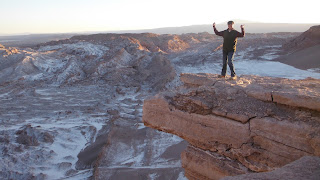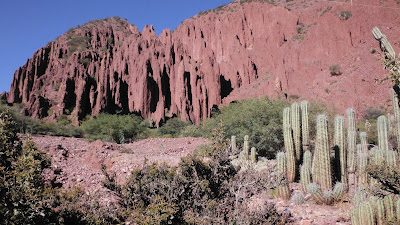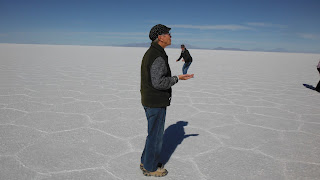1. When to go?
The prime vacation period in Chile and Argentina is January and February (equivalent to July & August in N. Hemisphere). Accommodations are harder to find and the popular places are crowded. We therefore decided on March to May. It worked out very well.
2. Overall strategy
Tierra del Fuego is not too far from Antarctica, so winter comes early there. We flew to Ushuaia first and slowly worked our way north, staying ahead of the winter and going back and forth between Argentina and Chile. Our original plan was to spend most of the time in Argentina, but in fact we were longer in Chile. Apart from the very south of Chile (no roads), the Transamericana highway in Chile is ideal for South/North travel, whereas in Argentina the roads tend to wander all over the place. Many of the prime destinations are on either side of the Andes, so the Chilean highways provide excellent access.
3. ResourcesThe prime vacation period in Chile and Argentina is January and February (equivalent to July & August in N. Hemisphere). Accommodations are harder to find and the popular places are crowded. We therefore decided on March to May. It worked out very well.
2. Overall strategy
Tierra del Fuego is not too far from Antarctica, so winter comes early there. We flew to Ushuaia first and slowly worked our way north, staying ahead of the winter and going back and forth between Argentina and Chile. Our original plan was to spend most of the time in Argentina, but in fact we were longer in Chile. Apart from the very south of Chile (no roads), the Transamericana highway in Chile is ideal for South/North travel, whereas in Argentina the roads tend to wander all over the place. Many of the prime destinations are on either side of the Andes, so the Chilean highways provide excellent access.
We found the latest versions of the Lonely Planet guides for Argentina and Chile to be excellent. Some of the backpackers didn't like the fact that these guides cater to various types of accommodation, including high end. This was not a problem for us, as mentioned below we used the Internet to select hostels.
4.Transportation
Argentina Airlines has good rates for internal flights - when booked from out of the country you get good prices but you get very little, if any, refund if you cancel and changes in scheduling are expensive. Also many of the inter-city flight legs only operate in prime summer season.We booked 3 legs - one to Ushuaia at the start of the trip and two (to & from Iguassu Falls) near the end. The fact that we did not book many internal flights turned out to be a godsend. We were able to be very flexible and go when we wanted to. Freedom.
The rest of the time we travelled by bus. The bus system in Argentina and Chile is far superior to that in Canada. The buses are more modern and they are better equipped. A few of the trips were as long as 15 hours, but most of those you can travel overnight. The overnight buses usually have an "Executive" class where the seats fold out horizontal for a good nights sleep. We were even served champagne on one trip.Travelling by bus is much less stressful than flying. Most bus terminals are downtown, much closer than the airport.You book ahead or even the same day, get seat selection, then show up about 15 mins. ahead of departure. Your large bags are stowed under (you get a tag) and away you go. No security lineups, long taxi rides and no need to show up 1 to 2 hours before departure. In addition to being modern and efficient, the buses are relatively inexpensive. Highly recommended! (Buses in Paraguay are another breed entirely - The ones we took must have been 40 years old).
5. Accommodation
We used hostels for the entire trip. We stayed in over 30 different hostels. With the exception of the jeep trip in Bolivia, we always had our own room, about half the time with ensuite bath. Some were great, some were good and a very few had some problems (eg all night dog barking nearby), but overall the experience was excellent. Hostels have so much more to offer for the traveller than hotels. They are cheaper, most include breakfast, you can cook your own food if you want, they have wi-fi and most have a couple of computers online for guest use plus there is normally a lounge where people congregate and socialize. Some of the best experiences we had on the trip were a direct result of information passed on by other backpackers that we were either unaware of or not planning to do. They are safe - you either have a key to the front door or you have to ring to be let in and you have your own room key.
 |
| Front doors of "Chill House" hostel, Buenos Aires |
The average age in the hostels was about 25 - 30, less than half our age. When we would first arrive, we would get some odd looks (Whats Gramps and Grandma doing here?!!) but once we made a bit of an effort to break the ice and they realized that we were doing exactly the same as them, there was no problem with the age difference. In fact we had some great dialogue.
There are several agencies that you can book through online (we used Hostelbookers.com most of the time). Their web sites list all the hostels in a given town that they are agents for along with ratings feedback from travellers. You can even read all the comments posted about any particular hostel. Following this regimen, we always had a very good idea of what we were booking. Many of the younger backpackers just show up looking for a dorm bed. Sometimes there is one available, sometimes not. But if you want your own room, it is better to book a couple of days ahead as most hostels have a very limited supply.
 |
| View of the Andes from our flight home. Winter is setting in (May 2013) |
 |
| Strange cloud formation over the Andes (volcano?) |
6. Language
It would definitely not be a good idea to do this trip with zero Spanish. You would miss a lot and it would be very frustrating at times. We had a very very basic vocabulary which expanded as we went and we had no problems at all. Once people realise you are a gringo, they tend to slow down and speak very basic Spanish. (Normally they tend to talk much faster than our ability to comprehend). In stores, virtually no one spoke any English. Even in visitor information offices it was rare to find an English speaker.
7. Safety, Security
The only place we were even the slightest bit concerned was in Buenos Aires (where we were robbed once - see blog). There you really have to keep your wits about you and be aware of people around you. Avoid standing around in full view studying a map. Check out the guidebooks for typical scams. Watch your daypack if you wear one. Armed robbery is highly unlikely. Ours was a "soft" robbery. This incident was the only time in the entire 3 months that we had concerns.
We did not carry wallets and purses. Normally we would leave all credit cards, passports etc locked up at the hostel and carry a small amount of cash. When moving we carried everything in money belts under our clothing. It is a little awkward at times when you need to show your passport, but it's worth it.
8. Health
Before we left home, we visited our local travel clinic and had any shots required. Other than some tummy problems following our jeep trip in Bolivia, we were really healthy the whole trip. In Bolivia, the altitude can be a problem. Insomnia and headaches, especially at night, are common and we experienced this. There are pills you can take for altitude sickness - one of us couldn't tolerate it due to constant nosebleeds - it seems to thin your blood.
One area where hygiene was suspect throughout our trip was public washrooms, even in restaurants. Rarely was there any toilet paper or paper towels and sometimes not even a toilet seat. We always carried a supply of paper with us. The hostels normally had very adequate bathroom facilities. Another concern we had at the outset was bedbugs. Over 30 hostels later, we never had a problem.
One health advantage we did not realise until we got home - after all the walking and hiking (we must have walked hundreds of miles in the three months) plus probably a lower calorie diet resulted in an 8 lb loss for each of us. Now if we can just keep it off!!
9. Laundry
We never found any self-serve laundromats similar to Canada, however there is an even better option. Every town of any size has at least one lavanderia (laundry). You drop your clothes off in the morning, then pick them up later that day - all cleaned , dried and folded. Not too expensive and it leaves you free for the day to do whatever.
10. Money
Last but not least on the agenda. Argentina and Chile operate on a primarily cash basis. Some large chain supermarkets and high end retail shops will take credit cards. A few others will accept cc's but charge a minimum of 10% for the privilege. Everyone else wants cash. ATM's that accept out of country debit or credit cards are available in most locations and that was the route we took. It is best to take out the daily maximum when you do use an ATM as the fee appears to be the same no matter how much you withdraw.
As mentioned elsewhere in this blog, take as much US cash as you are comfortable carrying into Argentina, since you can get almost twice the official rate on the "blue market". Talk to other travellers or locals before undertaking these "clandestine" operations - you want to make sure you are dealing with someone that you could find again if necessary. There have been reports of counterfeit bills. We found some small shops to be the best bet. Just ask for "cambio".
None of the other countries we visited on this trip had a black market.
One health advantage we did not realise until we got home - after all the walking and hiking (we must have walked hundreds of miles in the three months) plus probably a lower calorie diet resulted in an 8 lb loss for each of us. Now if we can just keep it off!!
9. Laundry
We never found any self-serve laundromats similar to Canada, however there is an even better option. Every town of any size has at least one lavanderia (laundry). You drop your clothes off in the morning, then pick them up later that day - all cleaned , dried and folded. Not too expensive and it leaves you free for the day to do whatever.
10. Money
Last but not least on the agenda. Argentina and Chile operate on a primarily cash basis. Some large chain supermarkets and high end retail shops will take credit cards. A few others will accept cc's but charge a minimum of 10% for the privilege. Everyone else wants cash. ATM's that accept out of country debit or credit cards are available in most locations and that was the route we took. It is best to take out the daily maximum when you do use an ATM as the fee appears to be the same no matter how much you withdraw.
As mentioned elsewhere in this blog, take as much US cash as you are comfortable carrying into Argentina, since you can get almost twice the official rate on the "blue market". Talk to other travellers or locals before undertaking these "clandestine" operations - you want to make sure you are dealing with someone that you could find again if necessary. There have been reports of counterfeit bills. We found some small shops to be the best bet. Just ask for "cambio".
None of the other countries we visited on this trip had a black market.






















































